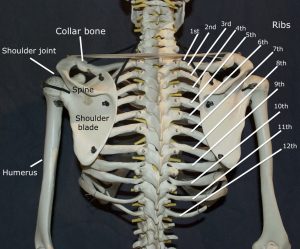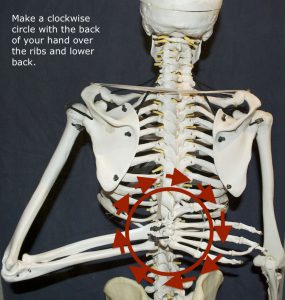
Use this Murdoch Minute to improve your hands and rein contact. When you can make continuous circles with your hand on your back at all gaits, your shoulders will be free to follow your horses mouth on the flat and over fences.
Noisy Hands?
Do your shoulders get tense when you ride? Have trouble keeping your hands quiet? Does your horse object to your contact? Instructor keep telling you to “keep your hands down!”? Poor hands are perfect examples of when trying harder makes the problem worse!
To keep your hands quiet you need to be sure your ribs are supporting your shoulders and to stop using the muscles that prevent your shoulder blades from gliding. Therefore, to solve the problem you need to do less!
Next time you ride observe what you do with your shoulder blades. Do you tense them upward toward your ears, pull them down strongly, hold them wide so that they are moving away from your spine? As you ride are your shoulders round, pulled back or resting on your back on top of your ribs?

Are you ribbing me?
Pulling your shoulders back to “sit up straight” requires a lot of muscle effort, which causes tension, making your rein contact hard. Strength training to hold your shoulders in place will make matters worse if your rib cage is not correctly aligned. The solution comes from properly aligning the rib cage and then getting rid of the residual muscle tension that prevents your shoulder blades from moving. When your shoulder blades glide over your ribs your arms and hands will be free to follow your horse’s mouth.
Shoulder Support
In previous installments and in both my Fixes books I talk about solving the problem of rounded shoulders by learning about your ribcage. Remember that this is what your shoulder girdle should be resting upon. If your sternum and rib cage are arched back or dropped forward there is no structural support for your shoulders. When the ribcage is incorrectly aligned you must use inappropriate muscles to keep your shoulders back. But the more muscle the less freedom, preventing your arms from following your horse’s mouth! (Please see my books and for more information, about aligning your ribcage for shoulder support.) But even when your ribcage is in place you may still have residual tension from your previous habits. This exercise will help you get rid of this excess tension.

Unmounted
Make a small, round and smooth clockwise circle with your hand on your back. Increase the circle size only when the movement is smooth and easy. Rest. Place the back of your hand on your back again and repeat the circle in a counter-clockwise direction noting which direction is easier. Observe the movement of your shoulder blade as you glide your hand toward the other elbow, up toward your head, down toward your tailbone and over to the same side.
Change arms – which one moves more freely? Does this correspond to the softer side of your horse’s mouth? If so spend time with the easy arm observing the movement in your collar bone and shoulder blade until you sense how they are moving to allow your hand to glide over the ribs. Then switch to the other arm and observe what is happening there. Continue to compare your two arms until the easy arm teaches the other one how to do this movement.
Mounted
On a quiet horse begin at halt first, circling with one arm and then the other. Always hold onto the reins with the other hand. Once you have practiced at the halt, repeat the exercise at walk, trot, and canter until your arm stays in motion (not rushing) regardless of the gait you are riding. Whenever your circular movement gets jagged, changes speed, or stops altogether, your contact will be hard on your horse’s mouth.
And always remember to enjoy the Ride!
Copyright© 2014. All rights reserved.




